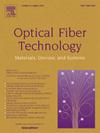Sampling frequency offset compensation scheme for single-carrier signals in coherent systems
IF 2.6
3区 计算机科学
Q2 ENGINEERING, ELECTRICAL & ELECTRONIC
引用次数: 0
Abstract
Transceiver sampling frequency offset (SFO) due to imperfections is one of the major factors restricting the transmission performance of the optical fiber coherent systems, especially when signals with high baud rate and therefore requiring higher sampling frequency of sampling devices like DACs or ADCs. In single-carrier signals transmission system, although adaptive clock recovery methods like Gardener or Godard method can compensate sampling error, when SFO is large enough so that one-frame length samples can accumulate to approximate one sample or above, the clock recovery will directly fail due to an extra sample is added or missed. The research of this issue for single-carrier signal is still rare. In this paper, we propose to use a digital interpolation method for single-carrier QAM signals for SFO compensation. The effectiveness of the proposed method is verified by a 32-GBaud 16-QAM dual-polarization 80-km SSMF optical coherent transmission experiment. The experimental results show that with proposed method, up to at least 1000-ppm SFO can be almost compensated to the bit error rate (BER) level as if without SFO. Besides, when using the proposed method, the required optical signal-to-noise ratio (OSNR) can be reduced by about 7 dB to achieve the BER level without SFO.
相干系统中单载波信号的采样频率偏移补偿方案
收发器因不完善而产生的采样频率偏移(SFO)是限制光纤相干系统传输性能的主要因素之一,尤其是当信号的波特率较高,因而需要较高采样频率的采样设备(如 DAC 或 ADC)时更是如此。在单载波信号传输系统中,虽然加德纳法或戈达德法等自适应时钟恢复方法可以补偿采样误差,但当 SFO 足够大,以至于一帧长度的采样可以累积到近似一个采样或更高时,时钟恢复就会因为额外增加或遗漏一个采样而直接失败。针对单载波信号的这一问题的研究还很少。本文提出了一种针对单载波 QAM 信号的数字插值方法,用于 SFO 补偿。通过 32-GBaud 16-QAM 双偏振 80 千米 SSMF 光相干传输实验验证了所提方法的有效性。实验结果表明,使用所提出的方法,至少可补偿 1000ppm 的 SFO,误码率(BER)几乎与无 SFO 时相同。此外,使用建议的方法时,所需的光信噪比(OSNR)可降低约 7 dB,以达到无 SFO 时的误码率水平。
本文章由计算机程序翻译,如有差异,请以英文原文为准。
求助全文
约1分钟内获得全文
求助全文
来源期刊

Optical Fiber Technology
工程技术-电信学
CiteScore
4.80
自引率
11.10%
发文量
327
审稿时长
63 days
期刊介绍:
Innovations in optical fiber technology are revolutionizing world communications. Newly developed fiber amplifiers allow for direct transmission of high-speed signals over transcontinental distances without the need for electronic regeneration. Optical fibers find new applications in data processing. The impact of fiber materials, devices, and systems on communications in the coming decades will create an abundance of primary literature and the need for up-to-date reviews.
Optical Fiber Technology: Materials, Devices, and Systems is a new cutting-edge journal designed to fill a need in this rapidly evolving field for speedy publication of regular length papers. Both theoretical and experimental papers on fiber materials, devices, and system performance evaluation and measurements are eligible, with emphasis on practical applications.
 求助内容:
求助内容: 应助结果提醒方式:
应助结果提醒方式:


